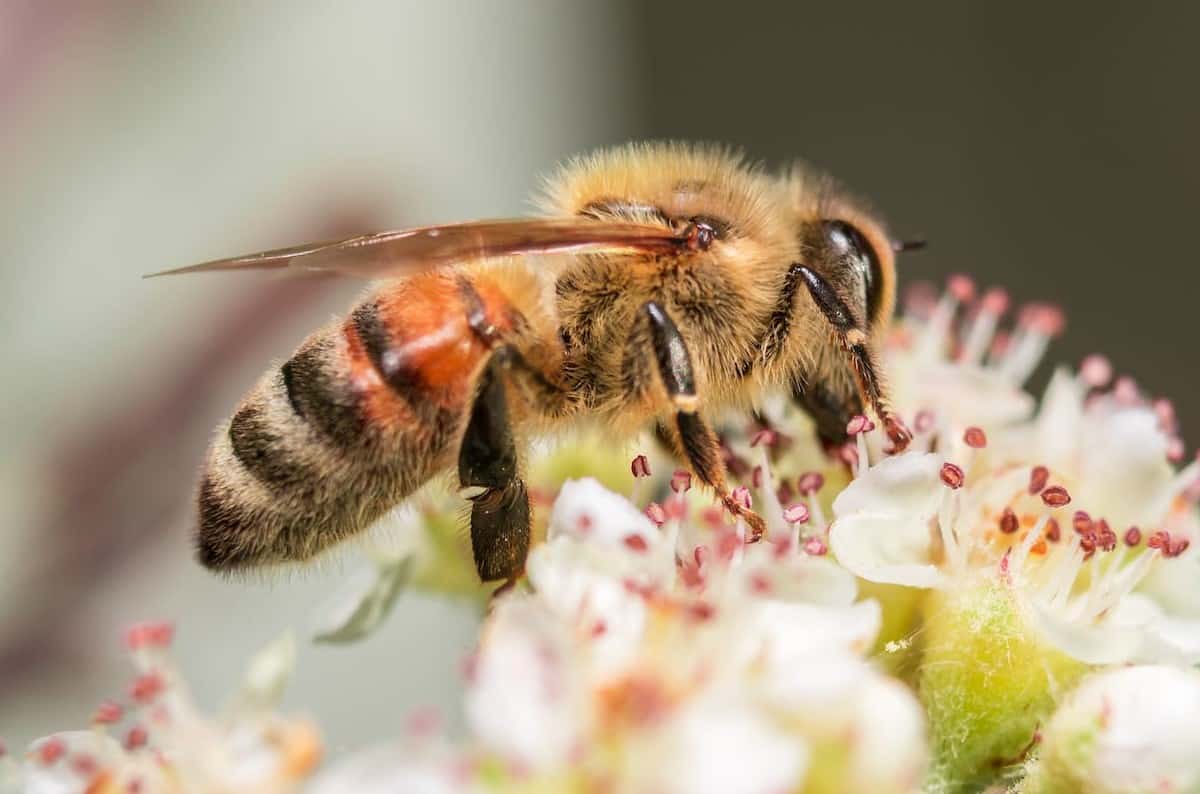Bees are one of the most important species on the planet, providing essential pollination services for many plants and crops. The anatomy of a honey bee is well adapted for the bees’ role as pollinators and for their social behavior.
It is incredibly complex and fascinating, having evolved over millions of years to become highly adapted to their environment.
In addition to their ecological importance, bees also have significant economic value. Honey bees, in particular, are used in the production of honey, beeswax, and other products.
Honey bees are effective pollinators, too. They likewise contribute to the balance of our ecosystem. The functions they perform in our environment are enhanced by their anatomy, which is specially designed to keep up with these roles.
In this blog post, we take a closer look at the honey bee’s anatomy and how it works to help the environment.
External Bee Anatomy
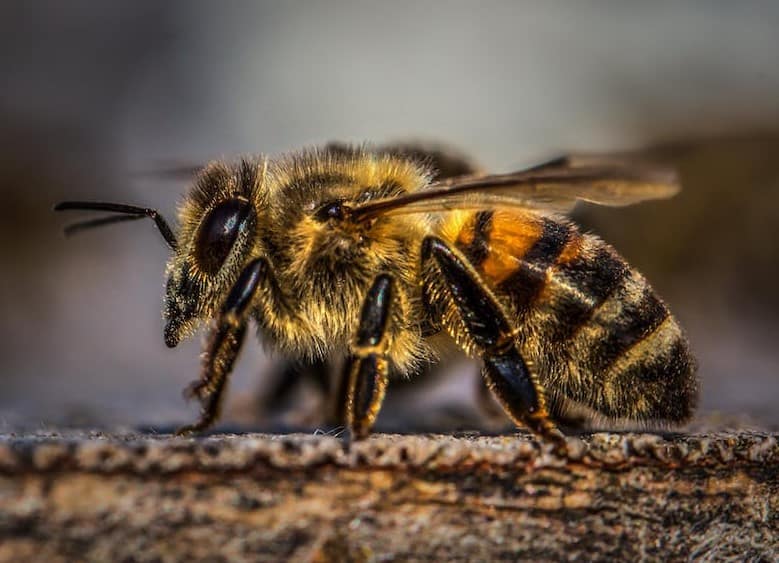
Honey bees have a three-part body consisting of the head, thorax, and abdomen. The head is equipped with two antennae, compound eyes, and a proboscis for feeding on nectar and pollen. The thorax contains three pairs of legs and two pairs of wings used for flight. The abdomen houses the reproductive organ as well as the stinger used for defense against predators.
Additionally, bees have an exoskeleton. It is the hard outer shell covered in a thin layer of wax, which helps to waterproof and protect the bee. It is made up of sclerites, which look like overlapping plates. The sclerites are made up of chitin, a flexible material made of a polymer of glucose.
Along with their sticky hairs, the exoskeleton provides protection from predators and environmental conditions, such as extreme temperatures or dryness.
It also helps to maintain body shape and support internal organs while allowing for flexibility in movement. Additionally, it helps to regulate water loss by preventing excessive evaporation from the body’s surface.
In addition to providing protection, the exoskeleton also plays a role in the bee’s immune system, as it is coated with chemicals that help to deter predators and parasites.
Head
The head of a bee is composed of several important parts, including the eyes, antennae, and mouthparts.
Bees do not have ears, but this does not mean that they cannot hear. They have other means of sound wave reception that help them in being aware of their surroundings.
Bees, likewise, have no noses, just like humans and most animals do. Rather, they have pairs of valves, called spiracles, on the thorax and abdomen where air passes through.
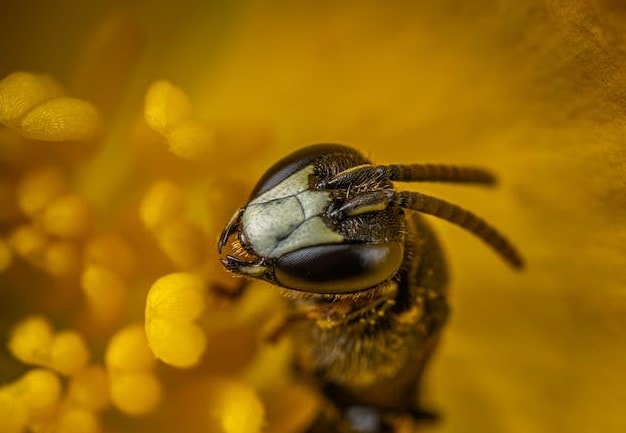
1. Antennae
The antennae of a bee are located on each side of the upper portion of the head and are made up of a number of segments. They act as mechanoreceptors and odor receptors.
Bees use their antennae to locate food sources, communicate with other bees, and navigate their way back to the hive. They are also important for detecting predators and avoiding danger.
In addition to their sensory functions, bee antennae also play a role in the bee’s social behavior, as they are used in courtship rituals and other forms of communication within the hive.
2. Eyes
The bee’s eyes are compound and allow the bee to see in multiple directions at once. The compound eyes of a bee are made up of thousands of individual lenses arranged in a hexagonal pattern.
The bee’s compound eye can detect movement, color, and even UV light.
3. Mouth
A honey bee has a mouth designed for gathering nectar from flowers. The bee’s mouth consists of two parts: the labrum, a flat plate used for collecting food, and the mandibles. The mandibles function as the bee’s teeth. These parts are used for chewing and manipulating food.
A long, flexible structure (like a tongue) called the proboscis is also found in a bee’s head, near its mouth and mandibles. At the end of the proboscis is a sponge-like structure called a glossa, which is used to suck nectar.
When not in use, the proboscis is folded up under the head of the bee.
Thorax
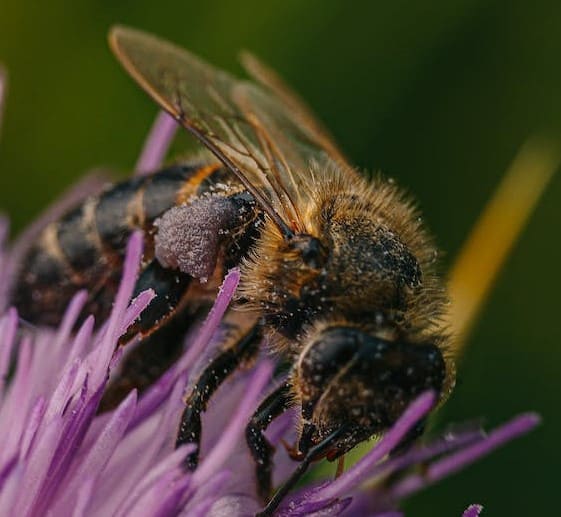
The thorax is the mid-region part of a bee’s body. This body part is primarily focused on locomotion. It holds the wings and the legs that are attached to it.
1. Legs
A bee has three pairs of legs that are made for specific purposes. The six legs of these social insects are the forelegs or front legs, middle legs, and hind legs or back legs. At the end of these legs are claws that allow bees to grip and stick to surfaces, even flat and smooth ones.
Primarily, the legs are used for walking. However, the foreleg (which is covered in stiff hairs) has the additional function of helping clean the bee’s antennae, while the hind leg holds the pollen baskets.
These legs also contain several sensory organs that allow the bee to detect vibrations and changes in its environment.
Pollen Basket
The pollen basket of a bee is located on the hind legs or back legs of a bee and is used to collect and transport pollen back to the hive. It consists of two flattened plates that are covered in tiny hairs called setae. These hairs help to trap and hold the pollen as the bee moves from flower to flower.
Additionally, the pollen basket can also be used to store nectar, which is then mixed with saliva and stored in honeycomb cells for later use.

2. Wings
A bee has two pairs of wings: the bee’s fore wings (larger) and the hind wings (smaller). Despite the differences in size, the fore wing and the hind wing work together hand in hand (should we say, wing in wing) in propelling the bee in flight.
The bee’s wings are covered in tiny scales that help reduce air resistance and increase lift. Additionally, they contain muscles that allow them to move in different directions, allowing the bee to maneuver when flying.
Two sets of flight muscles in the thorax pulsate in a quick manner that powers the movement of the wings. The longitudinal muscles contract to expand the thorax’s height, causing the wings to lower.
On the other hand, when the vertical muscles contract, the thorax reduces in height, causing the wings to be raised.
These muscles can contract many times, allowing honey bees to flap their wings more than 200 times in one second. The wings’ rapid flapping allows bees to fly fast for up to 15 miles per hour.
Abdomen
The bee’s abdomen is the hind region of the body and contains the stinger, wax glands, and pollen basket.
1. Stinger
The stinger of a honey bee is located at the end of the abdomen and is used as a defense mechanism against predators or other threats. The stinger is made up of two barbed lancets that are connected to a venom gland.
When a bee stings, the lancets penetrate the skin and pump venom into the victim. The bee will leave the stinger behind, which can continue to inject venom until it is removed.
2. Wax Glands
For a worker bee, the underside of its abdomen has glands that produce wax that hardens and becomes thin wax scales.
Liquid wax is also used to build honeycomb cells in the hive. It is secreted from eight pairs of glands located on the underside of the abdomen of bees and is mixed with saliva to form a sticky substance that can be molded into hexagonal shapes.

Internal Bee Anatomy
The honey bee anatomy consists of several organs that are essential to its survival.
Brain
The bee brain controls all bodily functions. It is a highly specialized organ that helps the bee to perform a wide range of behaviors.
Despite its small size, several parts of the bee’s brain work together to interpret what surrounds the bee. The optic lobes process what the bee sees with its eyes.
The antennal lobes process information the bee gathered through its antennae. Some parts deal with learning and memory and the coordination of movements of the parts of the bee’s anatomy.
Reproductive Organs
The reproductive organs of a bee are located in the abdomen and are responsible for producing eggs that will become new generations of bees when fertilized by drones.
When drones mate with female bees, sperm is transferred from the drone to the spermatheca of the queen bee. It is the storage facility for the sperm that queen bees collect during mating until it is used for fertilization.
The abdomen in drone bees also holds their sexual organs. After mating, these organs are detached from the drone bee, causing his death.
Digestive System
The digestive system is a series of organs working together to process food taken in by these bees.
When the bees consume nectar and pollen, it is taken in through the mouth. These foods mix with enzymes from salivary glands, making them easier to digest.
The food then passes the crop and through the midgut. It is where the majority of digestion and absorption takes place, after which it is pushed to the hindgut, where water and electrolytes are absorbed, and waste products are eliminated.
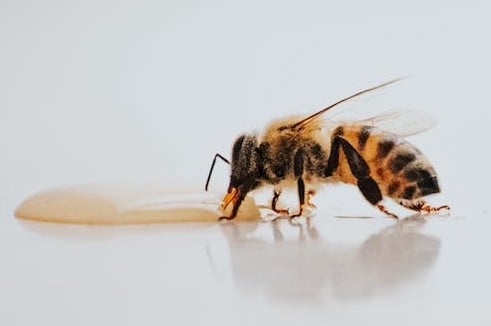
Respiratory System
Bees, like other insects, do not have lungs as humans do. Instead, they have a system of internal tubes called tracheae, which carry oxygen to cells throughout the body and remove carbon dioxide.
In a bee’s respiratory system, there is no separation between the inside and outside of the body. Oxygen and carbon dioxide are exchanged directly through the walls of the tracheae.
Bees also have spiracles on the sides of their thorax and abdomen, where air passes through.
Honey Stomach
The honey stomach (also known as the honey crop) is a second stomach in the bee’s body. It is different from the main stomach, where food eaten by bees is stored and processed (which supports the fact that honey is not bee vomit).
The crop does not digest nectars. It is merely a storage unit to hold nectar in. Its sole purpose is to store the nectar gathered by the bees until such time that they are back in their hives and can spit it out.
Final Thoughts on Bee Anatomy
The anatomy of a honey bee is an incredibly complex and fascinating subject.
Bees have evolved over millions of years to become highly adapted to their environment. The variety of specialized body parts enables them to thrive in their natural habitats.
